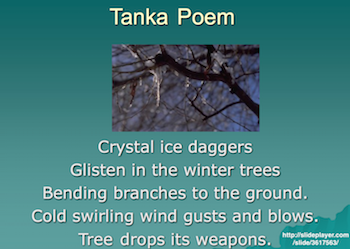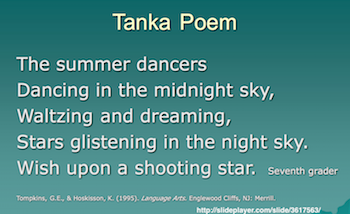4.10 More Patterns for Poems
| Site: | Cowichan Valley School District - Moodle |
| Course: | ELA5, CSS, Sferrazza |
| Book: | 4.10 More Patterns for Poems |
| Printed by: | Guest user |
| Date: | Sunday, 28 December 2025, 1:51 AM |
Learning Target
By the end of this lesson, you should be able to say YES to the following questions.
- Can I consider different purposes, audiences, and perspectives in exploring texts?
- Can I use language in creative and playful ways to develop style?
- Can I use writing and design processes to plan, develop, and create texts for a variety of purposes and audiences?

Words Have Rhythm
You've read poems to the "beat" and learned a bit about rhythm. Did you know that every word has a rhythm of its own?
The rhythm is found in the number of syllables in each word. Let's take a look.
Syllables
So now you know you can clap (or tap) each part of a word that you hear to count the number of syllables. Let's look at a few examples:
Bed - As you say "bed", you hear just one part" bed = 1 syllable.
Poem - As you say "poem", you hear two parts: po / em = 2 syllables (2 claps - clap when you say "po" and clap when you say "em")
Surprising - As you say "surprising", you hear three parts: sur / pri / sing = 3 syllables
Now it is your turn. Tap or clap each part that you hear as you say each word to find out how many syllables each word has.
Gallop
Comparisons
Metaphor
Stanza
Write
Poet
Syllable
Syllables in a Line
Some forms of poetry require the poet to know how many syllables are in a line.
For example:
BOOM! Thunder crashes like elephants in my room while the wind is a wolf howling at the moon.
How many syllables are in this line? To find out, say the line, and clap or tap each word part that you hear. You could also write down the line and put a "/" mark between each syllable. Try counting the syllables before checking the answer below.
Go to your Learning Guide and complete Syllables to practise this skill. Then return to this lesson.

Poems Are Universal
 Poems are “universal”; they are found around the world and in many different cultures. Today, you will be exploring and creating a poetry form that originates in Japan. Haiku (pronounced Hi-Koo) poems have lines that are based on syllables.
Poems are “universal”; they are found around the world and in many different cultures. Today, you will be exploring and creating a poetry form that originates in Japan. Haiku (pronounced Hi-Koo) poems have lines that are based on syllables.
Traditional Japanese Haiku are usually about nature or a season. They may show the loneliness found in nature, the peacefulness, or the beauty. They may show the moods of a season.
Haiku poetry follows this structure:
LINE ONE: 5 syllables
LINE TWO: 7 syllables
LINE THREE: 5 syllables
Introducing The Haiku
Here is an example.
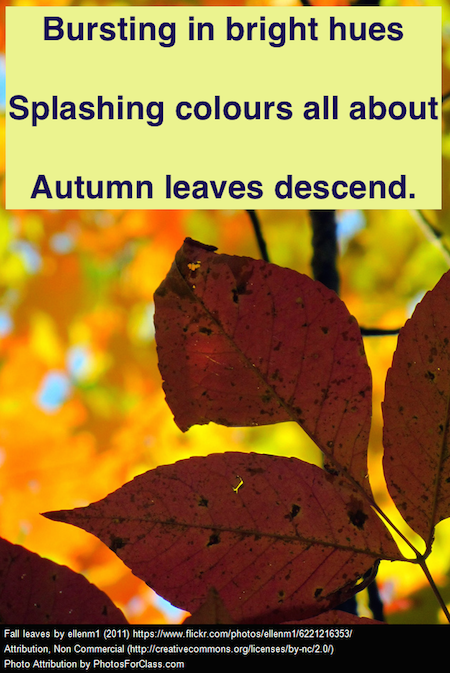
Check It Out!
Count the syllables:
Burs / ting / in / bright / hues (5)
Spla/shing / co/lours / all / a / bout (7)
Au/tumn / leaves / de / scend. (5)
Now try one about a mouse.
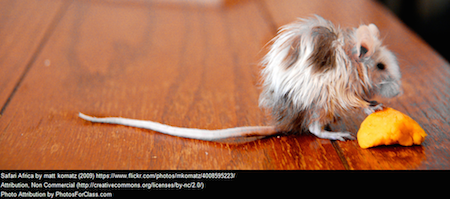
Close your eyes and picture in your mind a mouse holding some cheese between its little paws. Picture the mouse chewing. Notice its full cheeks. Can you describe this picture in seventeen syllables? Three lines with syllable counts of 5, 7, 5?
Take a look at this haiku:
LINE ONE: 5 syllables Lit/tle / spot/ted / mouse
LINE TWO: 7 syllables Nibb / ling / on / your / chees / y / snack
LINE THREE: 5 syllables Cheeks / bulg / ing / as / you / chew (Oops! This has six syllables.)
Line three has too many syllables. We need to get this line down to five syllables. In your Learning Guide, complete #5 to try to write a third line for this haiku that has only five syllables. Then, return to this lesson.

More Examples
Do you know what the topic of this haiku is?
Hours At Furnace
Several more spent building
Oops. No more glass.
If you guess minecraft, you are correct. Here are two more examples - one from nature and one from Pokeman. Which is your favourite? How does art enhance them?
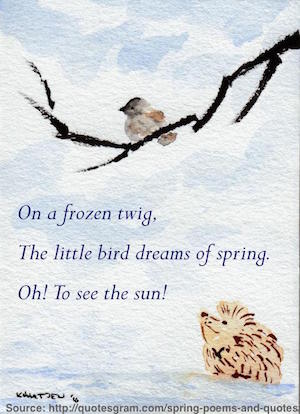

Your Turn!
Following along in your Learning Guide to complete Poetry Writing Task 5. Create your own haikus by following these steps:

Choose a topic. Haikus are usually written about nature. Do you have a favourite place in nature?
Sources of inspiration:
- pictures
- a favourite animal in its home
- the weather in a certain season (or in a storm)
You can choose a topic that isn’t about nature or the seasons, as well.

Now, try to capture this picture in three lines with correct syllable counts. Remember,
LINE ONE: 5 syllables
LINE TWO: 7 syllables
LINE THREE: 5 syllables
It make take more than one try to get your lines correct. That is normal! This is a first draft and it is OK to have words crossed out or even full lines crossed out. It is normal to need more than "one try" to get the syllables just right.
Give your haiku a title.
Revising and Editing
![]()
Make sure your syllables "fit" the formula.
Make changes to improve your writing. Try a few versions of each line and choose the "best" one.

- Patrol your writing for CUPS. Make corrections as needed.
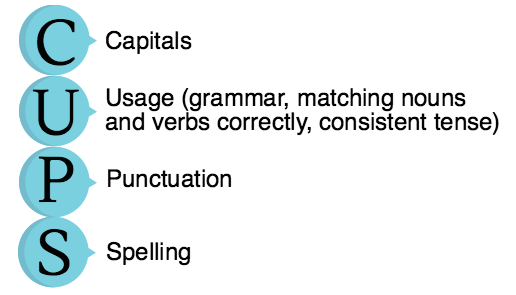
Next Steps
 The next step in the writing process is "Evaluating". In your Learning Guide, think and talk about the evaluating questions with your home facilitator. Decide how well you think your rough draft meets the criteria. Revise and edit your poem more, if you feel it is needed.
The next step in the writing process is "Evaluating". In your Learning Guide, think and talk about the evaluating questions with your home facilitator. Decide how well you think your rough draft meets the criteria. Revise and edit your poem more, if you feel it is needed.

 The last step is "Publishing". This step will be saved for project choices at the end of the poetry unit. For now, this lesson and poem are completed. Congratulations!
The last step is "Publishing". This step will be saved for project choices at the end of the poetry unit. For now, this lesson and poem are completed. Congratulations!

Do you have someone you can share your poem with now?
Optional Extension
If you enjoyed writing a haiku and want to try another Japanese poem, you can try writing a tanka.
Tanka is the oldest form of Japanese poetry.
Tanka poems are usually about nature, seasons, or love.
A tanka is based on syllables and follows this pattern:
LINE ONE: 5 syllables
LINE TWO: 7 syllables
LINE THREE: 5 syllables
LINE FOUR: 7 syllables
LINE FIVE: 7 syllables
Here are two examples:
